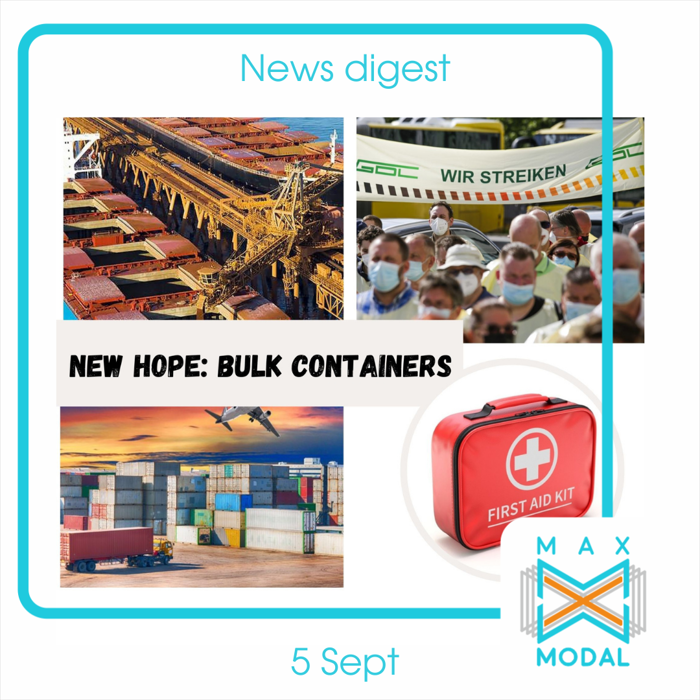News digest. 5 Sept
Moving containers on the fleet of bulk carriers may not be a panacea but at least it is a good band-aid straight from the first aid kit.
It seems like there is light at the end of the tunnel when it comes to alternatives providing a much needed support for supply chains for the shippers with urgent requirements. Bulk containers are the answer. The dry bulk owners have started to move containers on the dedicated fleet of bulk carriers, and, although it is not as efficient as companies would like it to be, it provides a considered relief to supply chains. Moreover, bulk carrier owners are eager to accept some high-paying containers. The dearth of cellular container tonnage in the charter market has also forced many companies to tap into the multipurpose (MPP) and open hatch bulk carrier markets to cover their needs this year.
Airfreight capacity remains tight as more restrictions are reinforced in China and congestion does not leave Bangladesh (alongside with continuous strike spree). As a result, the major retailers find themselves the hovering-up capacity to get their autumn/winter ranges to market, leaving smaller firms floundering. More shipping delays are expected in the future, so air forwarders should not rely on the marine sector and expect the situation to improve any time soon. On top of that, thanks to the ground operations in Shanghai, there has been a 10% drop in volumes on China to Europe direction in the last two weeks of August, while westbound capacity was reduced by 18%. Consequently, spot rates for air increased by nearly 20% in the last week of August compared to the last week of July.
There used to be high hopes for intermodal to become the most efficient alternative for transportation but as the situation unfolds, the future of it does not seem so bright due to the maxed-out trucking market. CSX will restrict the number of domestic containers it accepts from Chicago. Although intermodal is more competitive from a cost perspective, the deterioration in service levels is undermining its appeal. For everyone, all of this spells more misery ahead as the peak season shifts into high gear.
Anyway, it is too early to bury rail despite another upcoming strike in Germany. In the UK, British railways have drawn the audience’s attention by proving a possible solution for the drivers’ shortage. The concept of trunk operations by rail between efficient and conveniently sited hubs can be possible thanks to capacity released by pandemic-reduced passenger travel, and rolling stock now available for conversion. It is something the railway industry has not embraced for a long time, but experts say it is something that is about to change.
The crisis has demonstrated that expansion and joint efforts, perhaps, could be one of the possible ways to tackle the challenges. Thus, HMM, SM Line Corporation, Pan Ocean, Sinokor Merchant Marine, and Heung-A Line have started joint intra-Asia services under the K-Alliance engineered by the Ministry of Oceans and Fisheries. Although the latter was recently concerned about unfair competition of the lines, the voluntary membership in the alliance makes it better.
IKEA joins Walmart and Home Depot in the attempt to take matters into its own hands, revealing the decision to buy boxes and charter ships amid to address the growing port congestion around the world. Some experts believe that these giant shippers will have a good look at terminal handling charges that potentially could be a game-changer in their relationship with carriers, terminals, and forwarders.
MSC will one more nail in the coffin for the exporters by introducing its new increased peak season surcharge between Europe and the US by $1,000 per 40ft. Spot rates on the tradelane have leaped by about 180% in the past six months, indicating a rate of $5,888 per 40ft. As for the overall state, another month of high demand, overloaded infrastructure and intense negotiations for shippers, long-term contracted ocean freight rates now stand 85.5% higher than at this point last year.
Meanwhile, OOCL has entered into shipbuilding contracts for the construction of ten 16,000 TEU containerships following the trend of big players investing in their assets expansion. In turn, Fenix Marine Services had decided to focus on the infrastructure development and ordered four additional STS quay cranes its commitment to the partners at the ILWU, the terminal, and the future growth of the critical Port of Los Angeles gateway. The latter has recently noted that apart from investments in infrastructure, significant development of digitalization is needed as the splurge in e-commerce has added to the existing challenges that the port is facing.

